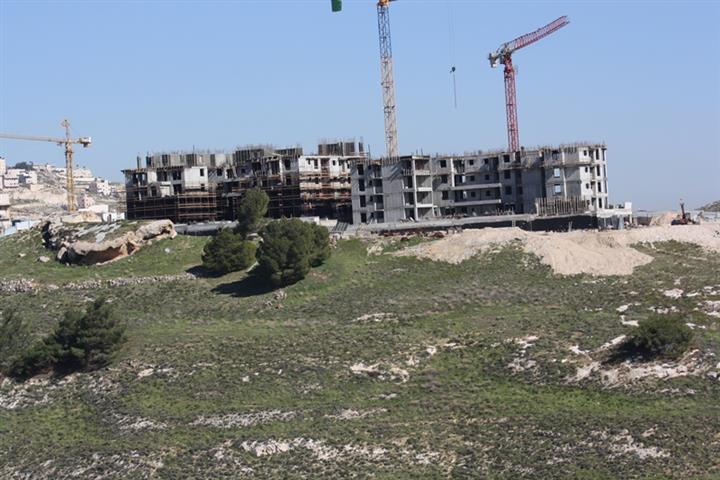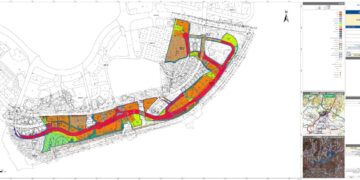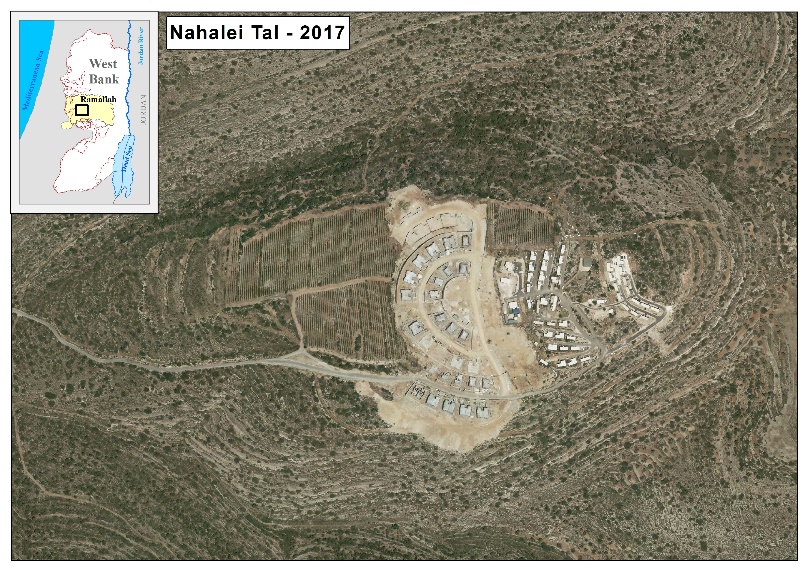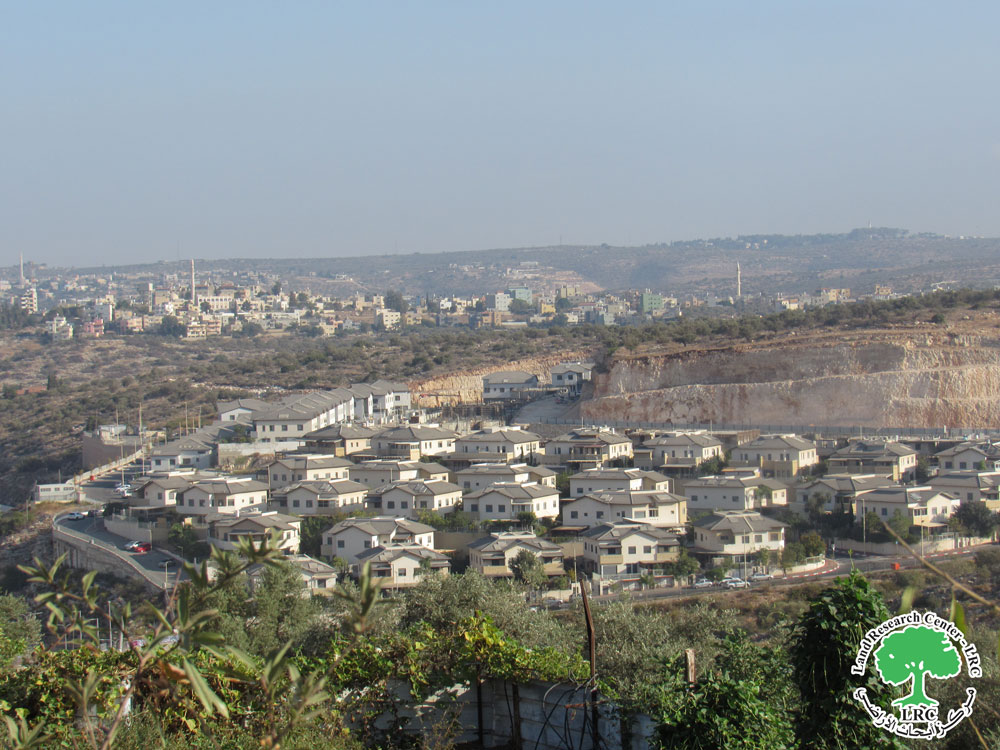A high-resolution satellite imagery analysis of Israeli settlement activity in the occupied West Bank (oWB) showed that during the period from May 2012 to May 2014, a huge expansion activity occurred in 162 Israeli settlements in the occupied West Bank (oWB), 82.6% of the total number of settlements in the oPt[1]). The analysis described in this report was conducted by the Applied Research Institute – Jerusalem (ARIJ) and sheds the light on the expansion occurring in Israeli settlements which impacted negatively on the landscape of the surrounding Palestinian communities. The pattern of expansion took the form of high apartment buildings and caravans, where 1741 buildings and 1079 caravans were recorded during the reporting period in addition to 330 new construction sites. The entire WB Governorates were affected by the Israeli expansion activity; however, among the most targeted Governorates were Ramallah, Jerusalem, Hebron, Bethlehem and Salfit Governorates. See Diagram 1
Israel consolidates the Judization of the Holy City, in what it calls the “Greater Jerusalem Plan”
Israeli has adopted a clear approach with regard to settlement expansion in occupied East Jerusalem. It focused mostly on Israeli settlements located within what it calls the "Greater Jerusalem", a comprehensive Israeli plan to annex an enormous area of the West Bank territory by annexing a belt of settlements that geographically separates the Israeli declared Jerusalem municipality boundary from the rest of the West Bank Governorates. This is actually exemplified in the construction of the Israeli Segregation Wall around the city of Jerusalem which will annex three major settlement blocs surrounding the city’s proper, and include the "Ma’aleh Adumim" settlement bloc east of Jerusalem, and the "Giv’at Ze’ev" settlement bloc northwest of Jerusalem and the "Gush Etzion" settlement bloc southwest of Jerusalem city. The number of settlements comprising the afore-mentioned settlement blocs constitutes 22.4% of the total number of settlements in the WB and are inhabited by 59% of the total number of Israeli settlers in the occupied West Bank, (718,000 Israeli settlers).
ARIJ’s analysis showed that during the reporting period, Israel has built a total of 371 new buildings and 255 caravans in 33 Israeli settlements comprising the blocs around Jerusalem city (out of 45 settlements). This rapid expansion aims at preventing Palestinian urban expansion in the areas surrounding the city of Jerusalem and consequently isolating the holy city from the rest of the occupied West Bank Governorates; The Expansion was most noticeable in the settlements of Giv’at Zeev, Har Samuel and Har Adar which are part of the Giv’at Ze’ev settlement bloc.; in addition, to the settlements of Atarot industrial Zone, Ramot, Pisgat Ze'ev, Pisgat Amir, Har Gilo and Har Homa located within the illegal municipal boundaries of Jerusalem city; Additional expansion was mostly noticed in the settlements of Beitar Illit and Efrata southwest of Bethlehem city and which are part of the "Gush Etzion" settlement bloc.
Netanyahu increases building in Israeli settlements in the Western Segregation Zone
Israel has also stepped up its settlement activity in Israeli settlements in the Western Segregation Zone (WSZ), in the area which falls between the 1949 Armistice Line (Green Line) and the Israeli Segregation Wall. During the past two years, expansion occurred in 58 Israeli settlements by 863 new buildings and 298 Caravans, most notably in the settlements located in what Israel classifies as “settlement blocs”. Expansion was more visible in the settlements of Ariel, Revava, Kiryat Netafim and Burqan which are part of the "Ariel finger” in Salfit Governorate, in addition to the settlements of Modi'in Illit, Matityahu, Shilat, Mevo Horon and Hashmonaiam which comprise the " Modi'in Illit " settlement bloc. west of Ramallah city. Note that a total of 1234 buildings (more than 8200 new settlement units) were added to the Israeli settlement in the WSZ during the past two years (including those in occupied East Jerusalem), the thing that portends the great danger that engulfs the Palestinian communities if the pace of settlement expansion continues that way and undermines any future efforts to reach a peace agreement with the Palestinians.
In fact, while Israel is exerting limitless efforts to expand Israeli settlements in the oWB, it continues to deny Palestinians building permits to build in areas that are still under its control, such as area "C" in the occupied West Bank and areas within the municipal boundaries of Jerusalem, under the pretext of unlicensed construction. During the reporting period, Israel carried out a wide demolition campaign in many Palestinian areas in the occupied West Bank affecting more than 560 Palestinian homes and 470 structures and putting more than 1,600 houses and structures at risk of demolition. On the other hand, the Israeli government, represented by its different ministries[2], did not fail to publish bids and plans to construct in Israeli settlements in an effort to strengthen its control over the land it occupies. During the past two years, the Applied Research Institute- Jerusalem (ARIJ) recorded more than 100 tenders issued for construction in Israeli settlements in the occupied West Bank, where most of these tenders targeted Israeli settlements in occupied East Jerusalem, especially those located within the municipal boundaries of Jerusalem, which was illegally and unilaterally re-drawn and annexed in 1967.
The Segregation Wall plan represents no end to expansion in Israeli Settlements
Israel has escalated settlement activity all over the occupied Palestinian territory and was not limited to settlements in the WSZ or those in and around Jerusalem city. In fact, the plan of the Israeli Segregation wall did not meet the aspirations of Israel's settlement project in the occupied Palestinian territory because many of the Israeli settlements that are of strategic, geographic and religious importance have remained on the eastern side of the wall, and Israel has not been able to include them in any of its colonial projects; however took the opportunity to continue investing in them to sustain their existence in the future. ARIJ’s analysis of Satellite imagery showed that during the past two years Israel has added a total of 507 buildings (nearly 500 new housing units) and 526 Caravans to 75 settlements located east of the Wall (out of 91). This expansion activity was mostly revealed in Israeli settlements located in Hebron Governorate, especially those located within the so-called "Har Hebron" corridor and include all of the following settlements: Ma'on, Beit Haggai, Ramat Mamrah (Kharsina), Telem, Carmiel, Tené (Ma'aleh Oomariam), Adora, Otniel and Susia. As well, expansion was recorded in Israeli settlements located in what Israel calls the "Gush Etzion East” which includes all of Nekodim, Tekoa and El david settlements (Kfar Eldad).
Other territorial corridors running from Ramallah and Nablus Governorates towards the Jordan valley and the Dead Sea area have been the center-focus of the Israeli Government expansion plan during the past few years, especially in the settlements of Eli, Mitzpe Rachel, Shilo, Bracha, Yetzhar, Itamar and Shavei Shomron in Nablus Governorate which constitute a territorial contiguity between Israeli settlements in the WSZ and those in the Jordan Valley; in addition to Talmon, Nahlaiel, Dolev, Kochav Hashahar, Rimonim and Ma’aleh Mikhmas settlements in Ramallah Governorate.
To conclude,
Despite the repeated international condemnation of Israeli settlement activities in the occupied West Bank, Israel continues to force irreversible facts on the ground and manipulate the geographic and demographic balance of the occupied territory, particularly in occupied East Jerusalem. The Israeli settlement activity destroys any possibility of fruitful negotiations to reach a peace agreement based on a two-state solution, with Jerusalem as the capital of both states; thus, it is clear that through its settlements activity, Israel intends to put an end to any prospect of a viable Palestinian state. These hardly seem the actions of a willing “partner for peace”.
[1] 196 settlements in the occupied West Bank
[2] Israeli Ministry of Housing and Construction, Israeli Land Administration and the Jerusalem Municipality, the Ministry of Foreign affairs.
Prepared by:
The Applied Research Institute – Jerusalem














